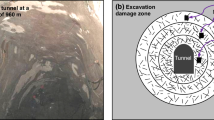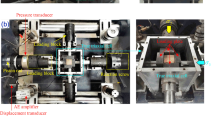Abstract
For investigating the effect of the initial cracks on the mechanical characteristics of mudstone specimens under uniaxial compression, firstly, uniaxial compression tests on mudstone specimens treated by different temperatures (20 °C, 30 °C, 60 °C and 80 °C, respectively) were carried out. Then, some uniaxial compression numerical models containing the certain number of initial elliptical cracks were built using finite-discrete element method (FDEM) to simulate laboratory tests. Lastly, a piecewise damage model was established to reveal the damage evolution process. It is found that the modelling results present a well agreement with laboratory tests in the aspect of stress-strain response. The test and simulation results reveal that initial crack density has a significant influence on the uniaxial compression mechanical characteristics. Specifically, with the increasing initial crack density, the initial nonlinearity is more obvious, but the elastic modulus and uniaxial compression strength are in decrease. And the cracking event counts are in decrease as increasing the initial crack density while the open fracturing mode is more dominant. Furthermore, the piecewise damage model can reproduce the stress-strain curves finely. If the initial nonlinearity is obvious, it is feasible to divide the damage evolution process into initial damage, damage decrease, and damage increase stages.

摘
要为研究初始裂纹对泥岩试件单轴压缩力学性质的影响, 首先, 对经过不同温度处理后的泥岩试件开展单轴压缩力学实验. 然后, 运用有限元-离散元耦合方法(FDEM)建立含有不同数量初始椭圆裂纹的单轴压缩数值模型来模拟室内实验. 最后, 建立一个分段损伤 模型揭示单轴压缩损伤演化过程. 通过研究发现模拟的应力-应变曲线与实验结果存在较好一致性, 实验和数值结果表明初始裂纹密度 对单轴压缩力学特性存在重要影响, 尤其是随着初始裂纹密度的增加, 初始非线性特征越明显, 而弹性模量和单轴抗压强度有所下降. 同时初始裂纹密度越大, 扩展的裂纹数量越少, 张拉破坏模式则越明显. 此外, 分段损伤本构模型能够很好地对应模拟和实验中的应力- 应变曲线. 对于初始非线性比较明显的岩石材料, 应该将岩石的损伤演化过程划分为初始损伤、损伤减少和损伤增加三个阶段.
Similar content being viewed by others
References
F. Birch, The velocity of compressional waves in rocks to 10 kilobars: 2., J. Geophys. Res. 66, 2199 (1961).
W. F. Brace, B. W. PauldingJr., and C. Scholz, Dilatancy in the fracture of crystalline rocks, J. Geophys. Res. 71, 3939 (1966).
Z. T. Bieniawski, Mechanism of brittle fracture of rock, Int. J. Rock Mech. Min. Sci. Geomech. Abstracts 4, 395 (1967).
M. Cai, P. K. Kaiser, Y. Tasaka, T. Maejima, H. Morioka, and M. Minami, Generalized crack initiation and crack damage stress thresholds of brittle rock masses near underground excavations, Int. J. Rock Mech. Min. Sci. 41, 833 (2004).
M. S. Diederichs, P. K. Kaiser, and E. Eberhardt, Damage initiation and propagation in hard rock during tunnelling and the influence of near-face stress rotation, Int. J. Rock Mech. Min. Sci. 41, 785 (2004).
Q. H. Qian, and X. P. Zhou, Effects of incompatible deformation on failure mode and stress field of surrounding rock mass, Chin. J. Rock Mech. Eng. 4, 649 (2013).
H. Shen, X. Li, Q. Li, and H. Wang, A method to model the effect of pre-existing cracks on P-wave velocity in rocks, J. Rock Mech. Geotech. Eng. 12, 493 (2020).
L. Li, G. Shi, Y. Zhang, and X. Liu, Relationship between the heterogeneity of low-permeability reservoirs and the dynamic evolution of fractures under uniaxial compression conditions by CT scanning: A case study in the jiyang depression of Bohai Bay Basin, China, Front. Earth Sci. 10, 1018561 (2023).
M. F. Ashby, and S. D. Hallam (Née Cooksley), The failure of brittle solids containing small cracks under compressive stress states, Acta Metall. 34, 497.
L. X. Xiong, H. J. Chen, and D. X. Geng, Uniaxial compression study on mechanical properties ofartificial rock specimens with cross-flaws, Geotech. Geol. Eng. 39, 1667 (2021).
R. Kong, E. Tuncay, R. Ulusay, X. Zhang, and X. T. Feng, An experimental investigation on stress-induced cracking mechanisms of a volcanic rock, Eng. Geol. 280, 105934 (2021).
C. Ding, R. Yang, and L. Yang, Experimental results of blast-induced cracking fractal characteristics and propagation behavior in deep rock mass, Int. J. Rock Mech. Min. Sci. 142, 104772 (2021).
H. Wang, Y. Wang, Z. Yu, and J. Li, Experimental study on the effects of stress-induced damage on the microstructure and mechanical properties of soft rock, Adv. Civ. Eng. 2021, 1 (2021).
M. S. Boussaid, C. Mallet, K. Beck, and J. Clara, Multi-geophysical approach for the characterization of thermally-induced cracks in granite: Discussion of reproducibility and persistence, Pure Appl. Geophys. 177, 3301 (2020).
Y. Shen, J. Hao, X. Hou, J. Yuan, and Z. Bai, Crack propagation in high-temperature granite after cooling shock: Experiment and numerical simulation, Bull. Eng. Geol. Environ. 80, 5831 (2021).
A. Daoud, J. Browning, P. G. Meredith, and T. M. Mitchell, Microstructural controls on thermal crack damage and the presence of a temperature-memory effect during cyclic thermal stressing of rocks, Geophys. Res. Lett. 47, 1 (2020).
Y. Zheng, Z. Ma, X. Zhao, and L. He, Experimental investigation on the thermal, mechanical and cracking behaviours of three igneous rocks under microwave treatment, Rock Mech. Rock Eng. 53, 3657 (2020).
C. A. Tang, P. Lin, R. H. C. Wong, and K. T. Chau, Analysis of crack coalescence in rock-like materials containing three flaws—Part II: numerical approach, Int. J. Rock Mech. Min. Sci. 38, 925 (2001).
P. Hamdi, D. Stead, and D. Elmo, Characterizing the influence of stress-induced microcracks on the laboratory strength and fracture development in brittle rocks using a finite-discrete element method-micro discrete fracture network FDEM-μDFN approach, J. Rock Mech. Geotech. Eng. 7, 609 (2015).
T. Yin, S. Zhang, X. Li, and L. Bai, A numerical estimate method of dynamic fracture initiation toughness of rock under high temperature, Eng. Fract. Mech. 204, 87 (2018).
J. Peng, L. N. Y. Wong, G. Liu, and C. I. Teh, Influence of initial micro-crack damage on strength and micro-cracking behavior of an intrusive crystalline rock, Bull. Eng. Geol. Environ. 78, 2957 (2019).
K. Feng, and X. P. Zhou, Peridynamic simulation of the mechanical responses and fracturing behaviors of granite subjected to uniaxial compression based on CT heterogeneous data, Eng. Comput. 39, 307 (2023).
S. Murakami, and K. Kamiya, Constitutive and damage evolution equations of elastic-brittle materials based on irreversible thermodynamics, Int. J. Mech. Sci. 39, 473 (1997).
E. Eberhardt, D. Stead, and B. Stimpson, Effects of sample disturbance on the stress-induced microfracturing characteristics of brittle rock, Can. Geotech. J. 36, 239 (1999).
W. H. Zhang, and Y. Q. Cai, Continuum Damage Mechanics and Numerical Applications (Zhejiang University Press, Hangzhou, 2010).
B. Paliwal, and K. T. Ramesh, An interacting micro-crack damage model for failure of brittle materials under compression, J. Mech. Phys. Solids 56, 896 (2008).
J. W. Zhou, W. Y. Xu, and X. G. Yang, A microcrack damage model for brittle rocks under uniaxial compression, Mech. Res. Commun. 37, 399 (2010).
N. Xie, Q. Z. Zhu, L. H. Xu, and J. F. Shao, A micromechanics-based elastoplastic damage model for quasi-brittle rocks, Comput. Geotech. 38, 970 (2011).
C. A. Tang, and X. Xu, Statistical damage analysis of the rock complete stress-strain process, J. Northeastern Univ. (Nat. Sci.) 2, 191 (1987).
W. G. Cao, M. H. Zhao, and X. J. Tang, Study on the model and its modifying method for rock softening and damage based on Weibull random distribution, Chin. J. Rock Mech. Eng. 6, 628 (1998).
S. Q. Yang, W. Y. Xu, L. D. Wei, and C. D. Su, Statistical constitutive model for rock damage under uniaxial compression and its experimental study, J. Hehai Univ. (Nat. Sci.) 2, 200 (2004).
J. B. Walsh, The effect of cracks on the compressibility of rock, J. Geophys. Res. 70, 381 (1965).
J. B. Walsh, The effect of cracks on the uniaxial elastic compression of rocks, J. Geophys. Res. 70, 399 (1965).
E. C. David, N. Brantut, A. Schubnel, and R. W. Zimmerman, Sliding crack model for nonlinearity and hysteresis in the uniaxial stress-strain curve of rock, Int. J. Rock Mech. Min. Sci. 52, 9 (2012).
A. Munjiza, The Combined Finite-Discrete Element Method (John Wiley & Sons, Chichester, 2004).
O. K. Mahabadi, Investigating the Influence of Micro-Scale Heterogeneity and Microstructure on the Failure and Mechanical Behaviour of Geomaterials, Dissertation for Doctoral Degree (University of Toronto, Toronto, 2012).
A. Munjiza, D. R. J. Owen, and N. Bicanic, A combined finite-discrete element method in transient dynamics of fracturing solids, Eng. Comput. 12, 145 (1995).
A. Lisjak, and G. Grasselli, A review of discrete modeling techniques for fracturing processes in discontinuous rock masses, J. Rock Mech. Geotech. Eng. 6, 301 (2014).
A. Hillerborg, M. Modéer, and P. E. Petersson, Analysis of crack formation and crack growth in concrete by means of fracture mechanics and finite elements, Cement Concrete Res. 6, 773 (1976).
Q. Zhao, Investigating Brittle Rock Failure and Associated Seismicity Using Laboratory Experiments and Numerical Simulations, Dissertation for Doctoral Degree (University of Toronto, Toronto, 2017).
Y. Ida, Cohesive force across the tip of a longitudinal-shear crack and Griffith’s specific surface energy, J. Geophys. Res. 77, 3796 (1972).
O. K. Mahabadi, A. Lisjak, A. Munjiza, and G. Grasselli, Y-Geo: New combined finite-discrete element numerical code for geomechanical applications, Int. J. Geomech. 12, 676 (2012).
A. Lisjak, Q. Liu, Q. Zhao, O. K. Mahabadi, and G. Grasselli, Numerical simulation of acoustic emission in brittle rocks by two-dimensional finite-discrete element analysis, Geophys. J. Int. 195, 423 (2013).
Z. Lei, E. Rougier, E. E. Knight, M. Zang, and A. Munjiza, Impact fracture and fragmentation of glass via the 3D combined finite-discrete element method, Appl. Sci. 11, 2484 (2021).
J. Peng, M. Cai, and G. Rong, Stresses for Crack Closure and its Application to assessing stress-induced Microcrack Damage, Chin. J. Rock Mech. Eng. 6, 10 (2015).
A. Munjiza, and N. W. M. John, Mesh size sensitivity of the combined FEM/DEM fracture and fragmentation algorithms, Eng. Fract. Mech. 69, 281 (2002).
Acknowledgements
This work was supported by the National Natural Science Foundation of China (Grant No. 41572334), Fundamental Research Funds for the Central Universities (Grant No. 2022YJSSB05), and a grant from State Key Laboratory for GeoMechanics and Deep Underground Engineering.
Author information
Authors and Affiliations
Contributions
Dejian Li designed the research methodology and provided the financial support for this study. Hao Qi conducted the present research and investigation process and wrote the submitted manuscripts. Chunxiao Li provided experimental data and implemented the computer code and supporting algorithms. Changqi Li applied computational techniques to analyze study data.
Corresponding author
Additional information
Conflict of interest
On behalf of all authors, the corresponding author states that there is no conflict of interest.
Rights and permissions
About this article
Cite this article
Li, D., Qi, H., Li, C. et al. Investigating the effect of initial cracks on the mudstone mechanical behavior under uniaxial compression using FDEM. Acta Mech. Sin. 39, 422421 (2023). https://doi.org/10.1007/s10409-023-22421-x
Received:
Accepted:
Published:
DOI: https://doi.org/10.1007/s10409-023-22421-x




